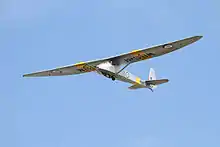Royal Air Force Gliding & Soaring Association
The Royal Air Force Gliding & Soaring Association is a British organisation which provides recreational flying in gliders to RAF personnel.
| Type | Charitable sporting and recreation organisation |
|---|---|
| Founded | RAF Detling, 1949 |
| Headquarters | Headquarters (RAFGSA Centre) - RAF Halton , England and Scotland |
Number of locations | 8 locations |
Area served | All RAF personnel and Armed Forces personnel engaged in Adventurous Training in Gliding |
| Services | Adventure Training and Flying training |
| Total assets | 60+ gliders, 8+ glider tugs and equipment to operate them. |
| Website |

Purpose
The Royal Air Force Gliding & Soaring Association (RAFGSA) is a voluntary organisation which exists to provide recreational flying to all RAF servicemen and women, in particular those normally employed in ground duties. The RAFGSA Centre is at RAF Halton, employing a full-time staff to provide central organisational, training and workshop facilities. [1] The Joint Services Gliding Centre (JSGC), located at the RAFGSA Chilterns Centre, RAF Halton, is part of the Joint Service Adventurous Training (JSAT) Air Sports organisation and provides training courses for military personnel.
History
In 1945, the British Air Forces of Occupation (BAFO) in Germany began using captured German gliders to provide recreational flying for RAF personnel. This resulted in a demand for similar facilities in the United Kingdom, and the Royal Air Force Gliding & Soaring Association was founded in 1949. The first aircraft, a Slingsby T.21 and a Prefect, were bought in March 1950 and stationed at RAF Detling. By 1952 27 gliders were being operated at seven clubs around the UK. [2] In October 1963 the RAFGSA Centre was established at RAF Bicester, absorbing the Windrushers Gliding Club which had been formed in January 1956 at RAF Little Rissington, later moving to Bicester. [3] In June 2004 the Centre moved to RAF Halton. [4]
Andy Gough
Warrant Officer Arthur William Charles Gough BEM, (b. 2 June 1924), for some 20 years ran the RAF gliding centre at Bicester as its Chief Flying Instructor.
In 1975 in the RAFGSA Championships he flew from Aston Down Airfield, near Cirencester, across the English Channel to Holland, beating the previous distance record of 315 miles by a further 3 miles.[5]
On 12 June 1982 he was giving an aerobatic display in a LET L-13 Blaník glider at RAF Brize Norton, but hit the ground and was killed. It was said that an object in one of the wings had become loose during the display and jammed the ailerons. He was then 58 years old.
The 'Andy Gough Memorial Trophy' is awarded annually to an outstanding RAFGSA member. WO Gough is also included on the armed forces memorial and armed forces roll of honour.[6]
Other notable Bicester glider pilots
Jock Wishart, Ron Newall, Ian Strachan, Con Greaves, & Paddy Kearon were gliding instructors and RAFGSA or BGA competition pilots.[7]
Dick Stratton
Richard B Stratton (1923 - 2007) FRAeS was a skilled aircraft engineer and a licensed CAA inspector.
He joined the RAF with a wartime commission and served as a flight engineer on Short Sunderland flying boats until 1949 when he joined Saunders Roe as a flight engineer for flight tests of the Saunders Roe Princess large flying boat. Later he was involved in the development of the Saunders-Roe SR.53 rocket plane.
He was skilled in aviation engineering and was an innovative influence in light aircraft and gliding practices This included safe aerotowing, winching and scroll-gear machining and elastic rope bungee launching.
He also successfully converted military de Havilland Canada DHC-1 Chipmunks to the civil register for aerotowing gliders, which were used by the RAFGSA and other gliding organisations from the late 1960s.
Chipmunk Innovations
The Chipmunk conversion from military to civil certification was unique because military chipmunks had Coffman cartridge starters which required the services of a qualified armourer and a licensed pyrotechnic store.
Dick Stratton's innovation was to disconnect the cartridge linkage, but not the assembly, as it would have altered the balance of the aircraft. Starting the motor by swinging the propeller can present a risk, and the CAA was initially reluctant to certify the modification, until Dick pointed out that "swinging the prop" was normal procedure with many other types of light aircraft.
Other modifications included a plywood seat panel over what had been space for a parachute (not essential for aero towing). Another addition was an dymotape embossed plastic label inscribed IAS VNE 120KT (Indicated Airspeed "Never Exceed" is 120 knots) (222Km/h)
Dick later converted some Chipmunks to accept Lycoming engines and enabled MOGAS (MOtive GASoline) to be used in some cases where the AVGAS (AViation GASoline) had been specified.
He continued to instruct, aerotow and innovate well into the 1980s.[8][9]
Clubs
Apart from the RAFGSA Centre at RAF Halton, there are six regional clubs run on a voluntary basis and based at or near RAF stations. Each offers initial training for novices as well as cross-country flying for more advanced pilots. [10]
- RAFGSA Chilterns Gliding Centre, RAF Halton
- Bannerdown Gliding Club, Keevil
- Cranwell Gliding Club, RAF Cranwell
- Fenland Gliding Club, RAF Marham
- Fulmar Gliding Club, Easterton
- Kestrel Gliding Club, RAF Odiham
- RAF Shawbury Gliding Club, RAF Shawbury
Aircraft
Approximately 60 gliders were in use in 2010, including the following types:[11]
See also
References
- RAFGSA website, retrieved 3 Aug 2011 Archived 5 April 2011 at the Wayback Machine
- Flight, 23 May 1952
- RAFGSA website: GSA History, retrieved 3 Aug 2011
- Windrushers Gliding Club website: Bicester Airfield History, retrieved 3 Aug 2011
- Facebook post by Paul Wells
- Memorial note
- Aviation Soaring newsgroup archive
- Times of London obituary
- Professional Pilots Forum
- RAFGSA website: List of clubs, retrieved 3 Aug 2011
- RAFGSA Fleet Distribution Archived 5 April 2011 at the Wayback Machine